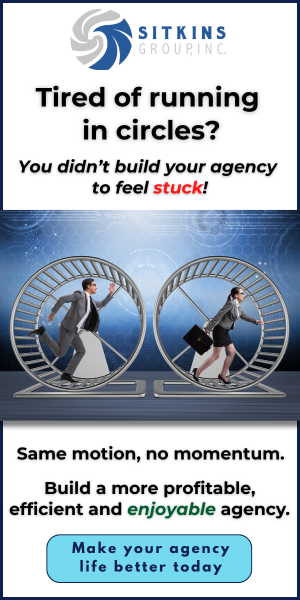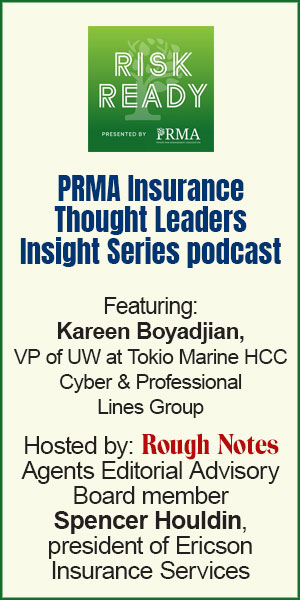Creating high-quality commercial
submissions for underwriters
When it comes to commercial account submissions,
there’s no such thing as too much information.
By Cheryl Koch, CPCU, ARM, AAI, ACSR, AFIS, and Mary Belka, CPCU, ARM, ARe, RPLU, CIC
When it comes to commercial account submissions, there’s no such thing as too much information. Underwriters—without whom we would have nothing to sell—are already working with a handicap, i.e., they seldom get to see what they are being asked to insure. The submission is how we “paint the picture” for them and bring the account to life.
We all want a competitive edge to help us write—and retain—our accounts. Developing relationships with underwriters can provide a needed advantage, especially when handling risks that might present an underwriting challenge. The key is to provide complete, accurate information in order to build trust—one submission at a time.
The best underwriters underwrite the agency as well as the risk. The best agencies understand the importance of building underwriting “capital” with carrier partners by consistently presenting clear, complete information—every time.
The information the producer and/or account manager collects for a complete submission should always be carefully reviewed before being compiled and forwarded to the carrier(s) for consideration. Learning to “think like an underwriter” is the secret sauce that will serve you well, when you can anticipate underwriters’ questions and answer them before they are asked.
Know your audience
We often talk about the different personality styles and how they contribute to high performance in the insurance industry. The four personality styles are:
- Talkers. These are those “life-of-the-party” types who have never met a stranger. It only makes sense that many producers exhibit those tendencies, since people are drawn to them and people buy insurance from people they like. These folks often don’t love detail.
- Doers. These are classic entrepreneurs, people who get things done. They don’t like a lot of small talk, and they don’t need a lot of detail to make a decision. Many commercial insurance clients are doers.
- Listeners. These are the empathetic souls who have a servant’s heart. They would much rather focus on you than talk about themselves. Not surprisingly, many account managers in independent agencies are off-the-chart listeners.
- Thinkers. Analytical people are those that just can’t get enough data and detail. Their biggest fear is making a bad decision because they didn’t have enough information or facts. Can you spell underwriter?
Is it any wonder, then, that a submission must contain sufficient information for an underwriter to feel comfortable with their decision to accept it and to formulate the right price for the exposures? After all, they have people to whom they must answer when things go wrong, and it’s an amazing fact that hindsight is 20/20.
Imagine your client suffers a huge loss and the underwriter is called in to the manager’s office and asked that age-old, somewhat ridiculous question—“what were you thinking?” In the eyes of management and the claims department, the underwriter clearly made a bad decision, but they couldn’t have known then what they now know. And much of what they knew then was based on the information contained in the agent’s submission.
While there may be some differences based on the individual underwriter, the insurance carrier, and the type of account being submitted, there are some universal truths when it comes to creating a high-quality submission. At a minimum, a complete submission consists of the following:
- Need-by date and target premium. Get submissions in early, let the underwriter know when you need the proposal, and give them a reasonable target premium.
- Applications. The standard-setting organization for our industry is the Association for Cooperative Operations Research and Development (ACORD). With few exceptions, every commercial submission should have a variety of completed ACORD forms attached based on the lines of business being submitted to the insurance company.
Every set of ACORD applications should always begin with the ACORD 125 – Applicant Information Section. This form is the foundation of a commercial application, and no submission is complete without it. One of the fields on the ACORD 125 is the Description of Operations.
We are always amused (tongue planted firmly in cheek) by the description of operations we see entered, e.g., machine shop. That’s it. No mention of what is being machined, nor how it is being machined, just machine shop.
Remember that we are trying to paint a picture for the underwriter, not give them a mystery to solve. All relevant—and complete—applications help to build an accurate picture. Additional information may be required to supplement and/or mitigate data that applications contain. (See below.)
- Narrative. Because of space limitations when completing ACORD forms, the Description of Operations field of the ACORD 125 does not allow for entry of the kind of information necessary to bring the applications to life. It would be far better to simply enter “see narrative attached.”
Every commercial account should have a complete narrative in the agency’s management system. Included would be a complete and thorough description of the insured’s operations, past and present, including their website, if they have one.
Don’t cut and paste from the website and transfer it to the application—the underwriter will review it and likely have questions, so answer anything that might concern them, including what may be contained on the website, in your narrative. In addition, the narrative should include the following information:
- Ownership and management. How did the firm get started? What is the management structure today? What experience, education, and/or expertise do the owners possess that sets them apart? What is the succession plan? Bottom line: What makes this organization better than its competitors?
- How experienced are the company’s employees? What is their historic turnover rate? How does the organization invest in employee training, education, and development?
- Loss control and safety management. What is management’s philosophy when it comes to loss mitigation? Attach all relevant documents that demonstrate the company’s commitment to loss control. If there have been losses in the past, emphasize what the organization is doing to prevent recurrence.
Physical plant and equipment. Provide details about every location, owned and non-owned, at which the insured has any operations. What type of equipment is being used? Are there backup or contingency plans in place if buildings, structures, or equipment is damaged or destroyed?
- Rating information. These include classification codes, exposure bases such as payroll and sales, and other relevant information that show how the company has evolved over time.
The narrative should contain sufficient detail for the underwriter to understand and classify the insured’s operations, and to develop appropriate pricing. It is not necessary, nor advisable, to simply reiterate the classification wording from the commercial lines manual (CLM) since the underwriter will have easy access to it.
The narrative is a living document and should be updated annually or as significant changes take place in the client’s operation. Imagine if a new account manager took over the account and had access to this level of information on day one—how much easier would it be for them to get up to speed when handling a new account?
- Loss runs. Current and five years (or more) of currently dated/valued loss information obtained from the incumbent and prior insurance carriers is a must. In a hard market, it might be better to have seven or more years, especially if loss trends have been going in the right direction. This is a visual representation of the insured’s commitment to safety and risk management. Be sure to include details about any large losses, including the current state of any reserves or settlements that might be “in the works.”
Other information such as flow charts, diagrams, photographs, videos, critical contracts, motor vehicle records (MVRs), strategic business plans, policy and procedures manuals, brochures and marketing information, and financial statements are nice to have but not absolutely necessary. Keep in mind that financial statements are generally a requirement for directors and officers (D&O) submissions.
Complete submissions save time
The conventional wisdom is that somehow cutting corners saves time. Producers (remember the personality types outlined above?) often tend to provide the bare minimum information, hoping more won’t be needed. It is our experience that this ultimately leads to more work and less trust.
The goal for the agency should be a complete submission, followed by a proposal from the carriers, without a lot of back-and-forth between the agency and the underwriter.
If you are constantly having to provide additional information to the insurer, your submission wasn’t complete in the first place. And if you have to continually contact the prospect or client for additional information, you are planting in their mind the fact that you’re not very efficient at running your own operation. That’s not a good image for someone you are asking to entrust their most valuable assets to you.
The best agencies train producers and account managers alike on how to efficiently collect what is needed and to help clients see and appreciate the importance—and advantage—in presenting an accurate picture of their risk to carriers. Doing this consistently will move your applications to the top of your underwriters’ stacks!
The authors
Cheryl Koch is the owner of Agency Management Resource Group, a firm providing training, education and consulting to producers, account managers and owners of independent agencies. She has a BA in Economics from UCLA and an MBA from Sacramento State University. She has also earned several insurance professional designations: CPCU, CIC, ARM, AAI, AAI-M, API, AIS, AAM, AIM, ARP, AINS, ACSR, AFIS, and MLIS.
Mary M. Belka is owner and CEO of Eisenhart Consulting Group, Inc., providing management and operations consulting to the insurance industry. She also is an endorsed agency E&O auditor for Swiss Re/Westport. A graduate of the University of Nebraska, Mary holds the CPCU, ARM, ARe, RPLU, CIC, and CPIW designations.





